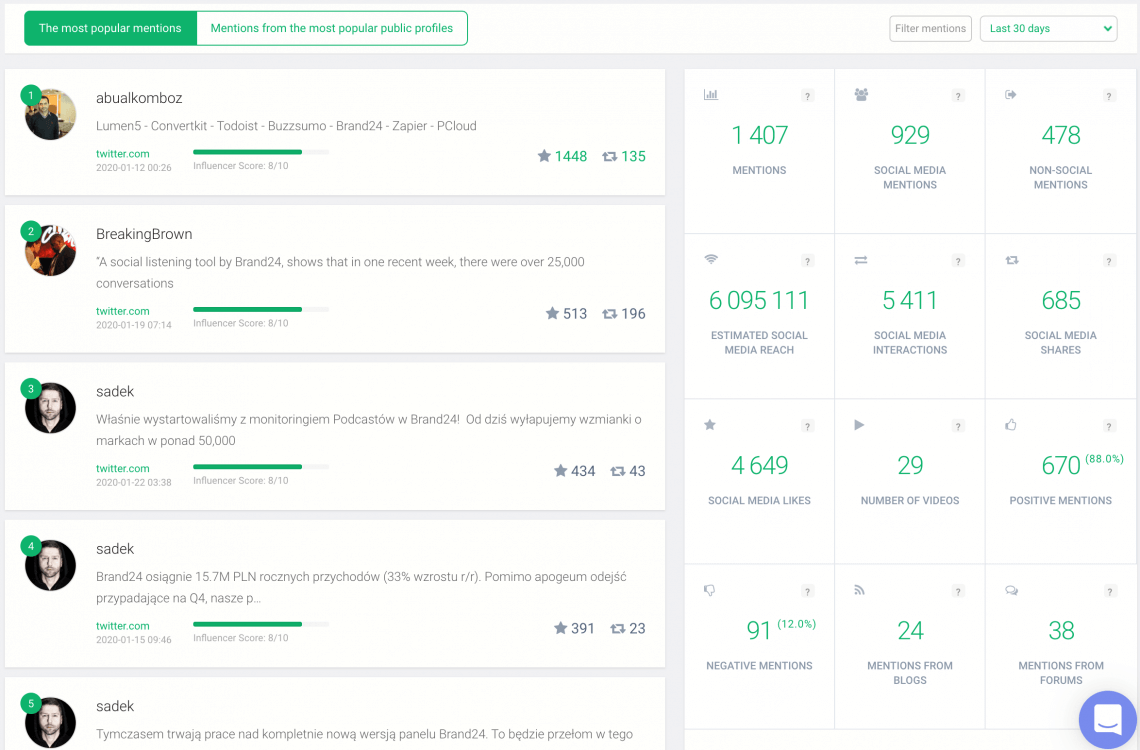How to Measure Social Media ROI?
Table of contents
Measuring social media ROI is an indispensable part of your social media strategy. At the end of the day, you need to know whether your social media marketing activities deliver the outcomes you need to bring your social media presence to the next level.
Measuring your social media ROI is, however, a problematic marketing area for many social media managers.
According to Sprout Social, 55% of social marketers said measuring the results of their social media activities is their number one challenge.
Why measuring social media ROI is such a problem?
One of the reasons might be the versatility of social media. You can build social media presence to sell your product, establish your company as an industry leader, run a promotion campaign, and much more.
Of course, you can easily measure the results of your paid ads, but what about other social media goals, for example, boosting your brand awareness or providing excellent customer service?
That’s another challenge when it comes to measuring the social media ROI. Not every action you undertake on social media will convert into money.
Many businesses neglect the social media ROI as they can’t see tangible results. That’s a mistake.
First of all, your customers expect to see your brand on social media. Before purchase, many people check Google reviews, Facebook reviews, read comments under your posts, and much more! They will find it suspicious, if they don’t find anything about your company online.
Secondly, building a strong social media presence might help your conversion rates. By building brand awareness you will be on your potential customer radar. And well-curated social media channel is just the place to establish your robust social media presence.
Each of your social media goals requires a different social media ROI metric. Some of them are easy to measure, while others are impossible to track without dedicated tools.
This blog post will help you learn how to measure your social media ROI for even better social media marketing results.
Here’s what’s ahead of us today:
Why do you need to measure social media ROI?
Before we delve into the nitty-gritty of measuring social media ROI, let’s establish some basic facts.
You might ask yourself, why bother with social media ROI in the first place? Especially, when it comes to measuring things that are hard to measure without the help of an external tool, for example, brand awareness or the sentiment around your brand.
The hard truth is, you need to start tracking ROI on social media.
First of all, a metric you can measure is a metric you can improve. Competition is fierce, especially when it comes to social media marketing. Knowing the exact effects of your social media presence will help you implement any necessary changes and stay ahead of the competition.
Secondly, many of us, if not the majority, need to present the results of marketing campaigns to your superiors. The metrics you present can make or break your social media campaign.
If you present metrics such as the total number of likes or followers, it won’t say much about the health of your social media marketing campaign. Especially now, in the times of bots and fake accounts made only to cheat the algorithms.
Measuring your social media ROI helps you prove the effectiveness of your social media marketing campaigns.
How to measure social media ROI?
Now that we established the importance of measuring your social media ROI, it’s time to see how exactly do you track the metrics that matter to you.
With a discreet help of some social media marketing tools, it’s easier than you think!
1. Establish social media objectives
That sounds, like a no-brainer, doesn’t it? Well, you’d be surprised how many social media marketing campaigns lack clearly established objectives!
Take a deeper loot at your social media presence. What would you like to achieve by being active on different social media channels?
Think about aspects such as:
- reaching new audiences;
- providing customer care;
- increasing brand awareness;
- selling your product or service via social media channels;
- preparing an in-depth competitors analysis;
- establishing your position on the market by becoming an industry leader.
Of course, you don’t have to limit your social media presence to just one goal. You can use Twitter to handle customers’ queries and Instagram to boost your brand awareness. The sky is the limit!
Just remember that every social media goal needs a different social media ROI metric to assess its success.
2. Set up goals
Once you know what you want to achieve, it’s time to set up social media goals.
Some people will tell you to set up SMART goals (specific, measurable, attainable, relevant, and timely). These people are 100% right.
What’s an example of a SMART goal?
“Increasing Twitter reach by 25% by the end of next quarter.”
You know exactly what you want to accomplish and when you have to deliver the results.
Setting up your social media goals according to the SMART technique will help you monitor the results of your actions and will add some structure to your social media presence.
3. Track the right social media metrics
Now comes the tricky part – measuring your social media ROI which means tracking the right numbers over a defined period.
There are 15 key social media metrics you need to track.
You’ll find some of the most important metrics in the native analytics tools of Facebook or Instagram as well as Google Analytics.
But you can also use the social media monitoring tool. The advantage of such a tool is its versatility.
You can monitor different social media platforms and compare the results within one dashboard. Moreover, all the metrics are gathered and analyzed using the same methodology so that you won’t compare apples to oranges.
You will get useful results. Also, you could draw some actionable conclusions.
4. Calculate all the expenses
To know the return, you have to calculate what the investment costs your precisely.
Although using social media channels is free, preparing content or analysing the results of your campaigns might not be.
Think about expenses such as:
- Social media tools. Native social media analytics tools won’t deliver some of the metrics you need; you’ll need some external tools to do that. For the time of the campaign, you should add the costs of the tools to your social media budget
- Social ads. That a relatively easy metric to follow. Every social media platform will show you how much you’ve spend on social media ads.
- Content. You can outsource content creation, be it developing a landing page or making sure your Facebook fan page is always up to date. You have to add these costs to your analysis.
- Time. Even if you pay an external agency to run the campaigns for you, you still have to monitor the results. If you do all the marketing activities in-house the time cost will be even higher. Take a look at the costs that were generated by specific campaign to measure the social media ROI.
Once you know what does your social media marketing cost, you can calculate the social media ROI.
How to calculate social media ROI?
Calculating your social media ROI when you have all the data is a piece of cake.
The good news is that there is a universal formula to calculate the social media ROI!
Profit/investment x 100 = Social Media ROI
Just a quick reminder – profit is calculated by subtracting revenue from investment.
The problem starts when you have to calculate the results of a marketing campaign which main aim was to generate brand awareness or improve your customer service rate.
What is the profit in these cases?
You won’t calculate the profit in terms of money, but rather take a look at how many people have seen your content, what is the sentiment around your marketing campaign, or what is your share of voice.
You can find all those metrics, and many more, inside your social media monitoring project dashboard.
The other parts of the equation stay the same.
Does is sound a bit abstract? Here’s an example!
Imagine you want to boost your brand awareness in Twitter. You decide to work with a carefully chosen influencer. You come up with a dedicated hashtag, so you can track the results of your campaign. The campaign will last for two weeks.
Before the campaign start (social media monitoring tool don’t collect historical data), you need to set up a project in Brand24. The keyword you want to track is your dedicated hashtag.
Once the campaign has ended you want to see the results and measure the social media ROI.

Log in to your account and take a look at the Summary tab. You’ll find a metric called “Estimated social media reach”. It will tell you how many people have seen your message during the duration of your campaign.
To measure the social media ROI you have to divide the social media reach by the cost of a campaign – the influencer fee and the cost of the tool.
So, it looks like this:
250 000/2 000 x 100 = 12 500
Remember that the final outcome is calculated as a percentage.
If you could find an influencer who could reach an audience this big for just 2 000 dollars, than your investment is definitely worth the effort!
What is a good ROI for social media?
Understanding what constitutes a good ROI for social media can be challenging due to the diversity of goals and metrics involved. A positive ROI means your revenues are greater than your costs, but how much greater will often depend on your specific industry, strategy, and goals.
Generally speaking, a positive ROI is a good starting point. If your ROI is greater than 0, you are generating more revenue from your social media activities than you are spending on them.
However, this doesn’t necessarily mean your strategy is effective. For example, if your ROI is 5%, this might not be sufficient, considering the time and resources invested in your social media campaigns.
Many experts suggest aiming for an ROI of at least 100% to justify the time, effort, and expense of a comprehensive social media marketing campaign. This means that for every dollar spent, two dollars are made. But, as with any metric, it’s important to compare this with industry benchmarks, historical data, and the ROI of other marketing activities.
You also need to consider your specific social media objectives. If your primary goal is increasing brand awareness or customer engagement, the ROI may not be measured in terms of immediate sales. In such cases, a large reach or high levels of engagement can be indicators of a successful campaign, even if they don’t directly translate into revenue.
Remember that social media marketing ROI isn’t the only metric that matters, and sometimes it might not even be the most relevant one. A lower ROI might be acceptable if your social media marketing is achieving other important objectives, such as improving brand reputation or customer satisfaction.
Ultimately, what constitutes a “good” social media ROI depends on your specific business goals, the nature of your industry, and the strategies you are using. Always aim to measure and track your ROI over time to understand trends, and make sure to consider the bigger picture of how your social media efforts are contributing to your overall business goals.
How do you measure your social media ROI?
Measuring social media ROI can bring you a lot of benefits. Think about the costs of unsuccessful marketing campaigns, lost revenue because of ineffective communication with your audience or poor customer service.
Measuring your social media ROI will help you determine which aspects of your social media marketing campaign are performing well and what elements you need to improve.
Focusing your marketing campaigns on achievable goals helps you bring the results you need to bring your company to the next level.
FAQ
What is the ROI in social media?
ROI, or Return on Investment, in social media refers to the benefits a business receives from its social media campaigns relative to the cost of those campaigns. Calculating social media ROI isn’t always straightforward due to the mix of tangible and intangible benefits. It often includes measures such as increased brand awareness, website traffic, and customer engagement, in addition to direct sales conversions.
What is the average ROI of social media marketing?
It’s challenging to provide a one-size-fits-all figure for the average ROI of social media marketing. The ROI can vary greatly based on factors such as the industry, target audience, chosen platforms, quality of content, and effectiveness of the social media manager. That being said, businesses should always aim for their social media marketing efforts to bring more value than they cost, with clearly defined, trackable metrics to gauge success.
How to increase ROI on social media?
To increase ROI on social media, you need to optimize your social media efforts for both cost and impact. This could include refining your target audience, improving the quality of your content, or using analytics from a social media management platform to inform your strategy. Additionally, engaging with your audience, leveraging user-generated content, and running targeted advertising campaigns can also boost your social media ROI.
HANDPICKED RELATED CONTENT
15 Social Media Metrics You Should Invariably Track
10 affordable news monitoring tools to keep you in the know
Related articles
Top Reads
Brand Monitoring: Tools & Guide for 2026
Brand Awareness Strategy [The Ultimate Guide for 2026]
The Best AI Hashtag Tracker and Other Hashtag Tracking Tools [2026]
Social Media Reach: How to Measure & Improve It in 2026?
X (Twitter) Analytics Tools: The 10 Best to Try in 2026
Sentiment Analysis: What is it & Why do You Need it in 2026?
Share of Voice: Definition, Calculation, Tools [2026 Guide]
Brand Reputation Management: 6 Expert Tips for 2026
A Complete Guide to AI Social Media Analysis [2025]
How to See How Many Times a Hashtag Was Used on X (Twitter)
Start Social Listening!
Get the Brand24 trial and start social listening like a PRO.


